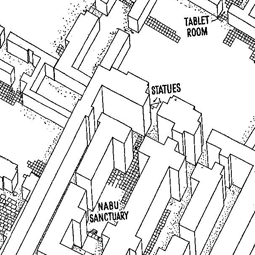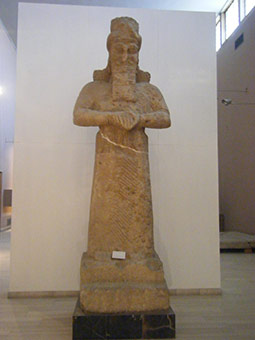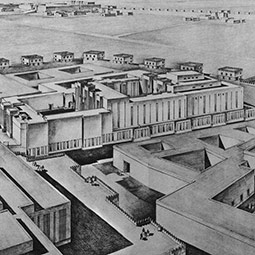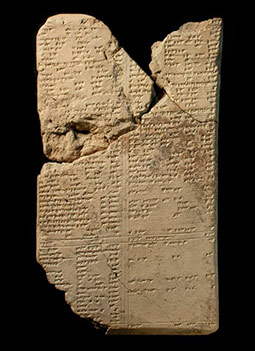Nabu, god of wisdom
Nabu, god of wisdom, was originally a Babylonian deity. However, over the course of the 1st millennium BC he became increasingly important in Assyria too. At first he was venerated primarily by literate bureaucrats and scholars TT , but by the end of the 8th century BC he had also become a central member of the Assyrian royal cult. He had at Kalhu, Nineveh, and (briefly) at Dur-Šarruken and Assur.
Babylonian origins
As the Ancient Mesopotamian Gods and Goddesses website explains, the earliest reference to Nabu is in the ancient Syrian city of Ebla in the 24th century BC. In early 2nd millennium Babylonia, Nabu was portrayed as a scribe TT of the great god Marduk. But he did not have his own temple and did not feature at all in Old Babylonian royal inscriptions.
By about 1100 BC Nabu had developed his first-millennium characteristics as lord of wisdom, first-born son of the supreme Babylonian deity Marduk, and lord of Ezida - the "true house" temple in Borsippa PGP . At around this time he also become particularly important to the Babylonian royal family (2).
Nabu in Assur
The earliest concrete evidence for Nabu's involvement in Assyrian scholarship come from the reign of Tiglath-pileser I PGP . A scribe named Aššur-šumi-aṣbat PGP working in the royal palace at Assur PGP had this prayer inscribed on his personal cylinder seal:
At the command of Nabu, exalted son of Ekur PGP (or: of the temple),
for the days I am alive, let me obtain justice,
let me uphold truth and rightness.
As soon as I enter the palace each time,
may my steps go well.
Seal of the scribe Aššur-šumi-aṣbat,
son of the royal scribe Ribatu (3).
Here Aššur-šumi-aṣbat invokes Nabu's guidance in serving the palace to the best of his ability, by behaving with appropriate decorum ("may my steps go well") as well as by acting wisely and fairly ("let me obtain justice, let me uphold truth and rightness").
Similarly, the scribe Aššur-išmanni PGP , who also served as one of Tiglath-pileser I's eponym TT officials, wrote a dedication to Tašmetu PGP , Nabu's divine spouse (4). However, Tiglath-pileser's own inscriptions do not mention Nabu at all (5). This suggests that at this time Nabu did not feature in royal cult but was worshipped in a personal capacity by senior literate state officials.
Trust in Nabu! The magnates of Kalhu
This trend continued at Kalhu (Image 1). When Assurnasirpal II made the city his capital in the early 9th century BC, a temple to Nabu was a very late addition to the citadel TT , and did not feature royal inscriptions. In fact, a king is named in just two places in the temple itself. Twin statues of divine attendants, 1.8m high, were placed to look from the gateway of Nabu's antecella into the courtyard below—and into the tablet TT store opposite (Image 2). They are dedicated to Nabu for the life of king Adad-nerari III PGP (r. 810-783 BC) and send a strong message of a personal relationship between the god and a human being:
To Nabu, heroic (and) exalted, son of Esaggila PGP , wise (and) splendid, mighty prince, heir of Nudimmud, whose command is supreme, skilled in the arts, trustee of all heaven and underworld, expert in everything, wise, the holder of the tablet stylus TT , learned in the scribal art, merciful (and) judicious, who has the power to depopulate (and) repopulate (a country), beloved of the god Ellil, lord of lords, whose might has no rival, without whom there can be no order in heaven, the merciful (and) compassionate whose benevolence is good, dweller in Ezida, which is within Kalhu, the great lord, his lord:
For the life of Adad-nerari, king of Assyria, his lord, and (for) the life of Sammu-ramat, the palace woman, his mistress: Bel-tarṣi-ilumma, governor TT of Kalhu (and) the lands of Hamedu PGP , Sirgana PGP , Temenu PGP , (and) Yaluna PGP , has had (this statue) made and dedicated (it) for his life, that his days might be long, his years many, (for) the well-being of his household and people, (and) that he might not become ill.
Whoever you are, after (me), trust in Nabu! Do not trust in another god! [Translation after (6)]
The statues' commissioner, Bel-tarṣi-ilumma PGP , was Adad-nerari's PGP eponym TT official in 797 BC (7) and a particular devotee of Nabu. His personal seal TT was found on sealings and a tablet in his Governor's Palace, right next door to the Ezida (8). The seal's inscription ends:
I have trusted in you, let me not be put to shame, O Nabu! (9)
Bel-tarṣi-ilumma was not the only senior court official with a particular affinity for the god of wisdom. Nergal-ilaʾi PGP , Adad-nerari's turtānu ("commander-in-chief"), inscribed a 5kg stone weight in the shape of a duck, which was found in the goddess Tašmetu PGP 's shrine. Lower down the ranks, the scribe Nabu-šallim-ahhe PGP dedicated a mace-head "to Nabu, his lord, for his life". It was discovered just outside the so-called "Fish Gate" (10).
In the light of all this evidence, it seems that in the 9th century BC Nabu was not a prominent figure in the divine pantheon of Kalhu. The temple did not attract much, if any, royal patronage, but was perhaps rather an entrepreneurial initiative by literate senior officials such as Kalhu's governor Bel-tarṣi-ilumma. The project must have been carried out with the king's blessing, almost certainly, for it entailed large-scale demolition and rebuilding on the royal citadel. But - as we have seen - all the inscriptional and geographical evidence points to personal piety rather than official cult.
Royal involvement: Sargon II and Dur-Šarruken
While both Assurnasirpal II and Adad-nerari III supported their magnates' TT trust in Nabu, they kept the cult at arm's length. It was only under Sargon II PGP that Nabu and his scholars became fully integrated into the highest echelons of court life. Even that was not an instant transformation.
The turning point was the capture of the northern city of Muṣaṣir PGP in 714 BC. Assyrian plundering of the god Haldi's ancient and wealthy temple not only secured Sargon's military reputation but also brought in substantial wealth, doubly confirming his right to rule. The famous Letter to Aššur, a report of his 8th military campaign, opens with acknowledgement of "the great support of Aššur, Šamaš PGP , Nabu (and) Marduk" (12) and consistently treats Nabu - always paired with his father Marduk - as a key factor in its success. Famously, it also contains the earliest extant reference to omens determining the course of an Assyrian military campaign:
At the exalted command of Nabu and Marduk (i.e. Mercury and Jupiter), who took a course through the positions of the stars (which signified) a good omen TT for the taking up of my weapons, and favourable signs which mean the gaining of power, Sin PGP , lord of the crown, remained eclipsed for a watch, (a portent) for the ruination of the Guti. At the invaluable consent of the hero Šamaš, who caused the liver to be inscribed with reiable omens that he would walk at my side ... I took the road to Muṣaṣir, a difficult path (13).
Here, observed planetary and lunar omens are confirmed through the taking of extispicies TT , as also in 7th century court practice. Clearly, then, the scholars had proved their worth - and the value of their gods—to Assyrian kingship. This was spectacular, decisive proof of scholarship's value in predicting and determining the outcome of battle by maintaining clear lines of communication with the gods.
From this point onwards, Nabu occurs routinely, if not inevitably, in Sargon's royal inscriptions as far afield as Cyprus PGP and northwest Iran.
Sargon's victory at Muṣaṣir proved a turning point, for the rich spoils enabled him to complete the construction of a new capital city, Dur-Šarruken PGP (modern Khorsabad PGP ), some 50 kilometres upriver from Kalhu, which had already begun in 717 BC. Unconstrained by existing building, Sargon's planners were free to create the royal citadel in Dur-Šarruken exactly as the king wanted. That new vision put Nabu at its very heart. In one of the earliest Dur-Šarruken inscriptions, written in 713 (or soon after) on clay cylinders deposited all over the citadel, Sargon claims to have commissioned the bricks for the palace "on the day of an eššēšu-festival for Bel's PGP son, the exceedingly wise Nabu, scribe of everything, who gives orders to all the gods".
Sargon built an enormous temple for Nabu right next door to the palace (Image 3), linked by a private bridge (14). It was was bigger and better than the one at Kalhu, though clearly heavily influenced by it. And while, as we have seen, the Kalhu Ezida lacked royal inscriptions, the major thresholds of its successor at Dur-Šarruken were inscribed with a prayer, proclaiming Sargon's piety towards Nabu:
O Nabu, scribe of the universe, controller of harmony: (as for) Sargon, king of the world, king of Assyria, city governor of Babylon, king of Sumer and Akkad, builder of your shrine—look steadily with firm heart and direct your just face towards him, provide him with many days of bodily good health and fix years of wellbeing as his fate.
May his reign be as long as heaven and earth; may he perform the shepherdship of all the lands; may his foundations be as firmly established as this building (site) and platform! [Translation after (15)]
Nabu at Nineveh
Nineveh had been an important Assyrian city for many centuries. Nabu had a temple on the citadel from at least the early 8th century. The standard Assyrian eponym list TT , which rarely mentions particular events, tersely notes: "foundations of Nabu's temple in Nineveh laid" in 788 BC (Adad-nerari's 23rd regnal year) and "Nabu entered the new temple" in 787 (SAAS 2: 2). Unfortunately we know almost nothing else about this temple until the reign of Assurbanipal.
As a boy Assurbanipal had trained for the priesthood because he was not a direct heir to the Assyrian throne (16). However, when his father nominated him as crown prince TT in 672, he cannily made the most of this unorthodox preparation for the role, and headed off possible worries about his suitability, by stressing his identification with the scholarly Nabu, "crown prince of the gods" as Marduk's heir (Image 4).
Assurbanipal's scholarly ambitions and personal devotion to Nabu are very well known (17), (18). They are manifested in prayers and dialogues with the god (SAA 3: 6, 13), the colophons TT on his extensive personal collection of scholarly tablets which comprise "almost every tablet of importance in the Kouyunjik Collection TT " (19), as well as numerous official inscriptions and the repair programmes for Nabu's temples in Kalhu and Nineveh (20).
In 652 BC, Assurbanipal's "favourite brother" Šamaš-šumu-ukin PGP turned traitor and allied with his Elamite PGP neighbours to wage a war for Babylonian independence. In keeping with his lack of military training, Assurbanipal did not lead the army in the field but stayed in Nineveh. He used his scholarly abilities to ensure divine support for Assyria through reading celestial TT omens TT and inducing prophetic messages TT from Ištar PGP . After the victory, as a gesture of thanks to his divine counterpart Assurbanipal enlarged and repaved the main courtyard of Ezida in Nineveh, attributing the ultimate success of his military strategy to "the placing of (Nabu's) order and the giving of his weighty command". Assurbanipal's learned, non-combatant approach to kingship looked to be amply justified.
Nabu at the end
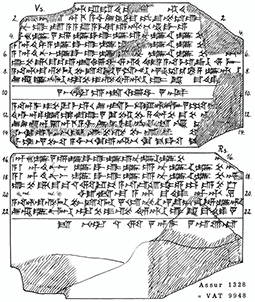
Tablet recording offerings by Sin-šarru-iškun. He dedicated two gold washing bowls to Nabu and a silver serving spoon to Tašmetu. (21) Source: Margarete Falkner, "Neue Inschriften aus der Zeit Sin-šarru-iškuns", AfO 16 (1952-1953), p. 305-310. © Archiv für Orientforschung (AfO), Institut für Orientalistik, Universität Wien. View large image (199 KB).
Over the course of the 640s Assyrian court scholarship fell into a dramatic decline. Cultic activity - if not scholarship - continued at the various Assyrian temples of Nabu. As late as 618* TT BC palace personnel were still making small but high-value votive TT offerings to Nabu in the Nineveh Ezida (SAA 7: 81). At Kalhu too, the Ezida continued to function perhaps right until the end of empire.
The final big gesture of Assyrian royal reverence for Nabu was made by, or for, Sin-šarru-iškun PGP (r. c.627–612 BC), the last king of Assyria. During the very first year of his reign, when he must still have been a child, a completely new temple to Nabu and Tašmetu was constructed in the heart of Assur PGP , the ancestral city.
Sin-šarru-iškun's inscriptions say that Nabu's original temple in Assur had "turned into waste-land, became (nothing but) ground" and so Nabu and Tašmetu had taken up residence in Ištar's temple. In fact, there is no independent evidence for an earlier building, and it is likely that the divine pair had had shrines in Ištar's temple all along.
Whatever the truth of the matter, Sin-šarru-iškun now gave them their own cult centre, based on earlier models, with twin shrines and antechambers for the divine couple and a throne room for himself. He also dedicated two gold washing bowls to Nabu and a silver TT serving spoon to Tašmetu.
However, there is no architectural or inscriptional evidence that the temple ever served as a scholarly centre and Sin-šarru-iškun characterises Nabu as an "honest judge who speaks truth and justice" rather than as a learned scribe. Just as scholars had disappeared from Assyrian court circles, so had the image of Nabu as the divine patron of scholarship.
Content last modified: 18 Dec 2019.
References
- Mallowan, M.E.L., 1966. Nimrud and Its Remains, vols. I-II, London: Collins, pp. 233, Figure 195. (Find in text ^)
- Pomponio, F., 1998-2001. "Nabû (A). Philologisch", in D.O. Edzard (ed.), Reallexikon der Assyriologie und Vordersasiatischen Archäeologie 9, Berlin: Walter de Gruyter, pp. 16-24, pp. 17–19. (Find in text ^)
- Deller, K., 1982. "Das Siegel des Schreibers Aššur-ṣumī-aṣbat, son of Rībāte", Baghdader Mitteilungen 13: 143-154. (Find in text ^)
- Grayson, A.K., 1991. Assyrian Rulers of the Early First Millennium BC: I (1114-859 BC) (Royal Inscriptions of Mesopotamia. Assyrian Periods. Volume 2), Toronto: University of Toronto Press, pp. 83-84, A.0.87.2001. (Find in text ^)
- Grayson, A.K., 1991. Assyrian Rulers of the Early First Millennium BC: I (1114-859 BC) (Royal Inscriptions of Mesopotamia. Assyrian Periods. Volume 2), Toronto: University of Toronto Press, pp. 7-71, A.0.87.1-30. (Find in text ^)
- Grayson, A.K., 1996. Assyrian Rulers of the Early First Millennium BC II (858-745 BC) (Royal Inscriptions of Mesopotamia. Assyrian Periods. Volume 3), Toronto: University of Toronto Press, pp. 227, A.0.104.2002. (Find in text ^)
- Millard, A.R., 1994. The Eponyms of the Assyrian Empire 910-612 BC (State Archives of Assyria Studies 2), Helsinki: Neo-Assyrian Text Corpus Project, p. 57. (Find in text ^)
- Postgate, J.N. and J.E. Reade, 1976-1980. "Kalhu", Reallexikon der Assyriologie und Vorderasiatischen Archäologie 5, Berlin: Walter de Gruyter, pp. 303-323, p. 316. (Find in text ^)
- Grayson, A.K., 1996. Assyrian Rulers of the Early First Millennium BC II (858-745 BC) (Royal Inscriptions of Mesopotamia. Assyrian Periods. Volume 3), Toronto: University of Toronto Press, pp. 228, A.0.104.2003:6-7. (Find in text ^)
- Mallowan, M.E.L., 1966. Nimrud and Its Remains, vols. I-II, London: Collins, pp. 257, 269 (vol. I). (Find in text ^)
- Loud, G. and C.B. Altman, 1938. Khorsabad, Part 2: The Citadel and the Town, Chicago: The Oriental Institute of the University of Chicago, p. 12. (Find in text ^)
- Thureau-Dangin, F., 1912. Une relation de la huitième campagne de Sargon (714 av. J.-C.) (Textes cunéiformes du Louvre 3), Paris: Geuthner (free online edition at The Internet Archive), pp. 5:i 13. (Find in text ^)
- Oppenheim, A.L., 1960. "The City of Assur in 714 B.C.", Journal of Near Eastern Studies 19, pp. 133-147 (PDF available via JSTOR for subscribers), pp. 136-138. (Find in text ^)
- Loud, G. and C.B. Altman, 1938. Khorsabad, Part 2: The Citadel and the Town, Chicago: The Oriental Institute of the University of Chicago, pp. 56-65. (Find in text ^)
- Fuchs, A., 1994. Die Inschriften Sargons II. aus Khorsabad, Göttingen: Cuvillier, pp. 370, no. 3.2.5. (Find in text ^)
- Novotny, J. and J. Singletary, 2009. "Family ties: Assurbanipal's family revisited", in M. Luukko, S. Svärd and R. Mattila (eds.), Of God(s), Trees, Kings, and Scholars. Neo-Assyrian and Related Studies in Honour of Simo Parpola (Studia Orientalia 106), Helsinki: Finnish Oriental Society, pp. 167-177 (free PDF from Knowledge and Power, 1.3 MB). (Find in text ^)
- Livingstone, A., 2007. "Ashurbanipal: literate or not?", Zeitschrift für Assyriologie 97, pp. 98-118. (Find in text ^)
- Frahm, E., 2011. "Keeping company with men of learning: the king as scholar", in K. Radner and E. Robson (eds.), The Oxford Handbook of Cuneiform Culture, Oxford: Oxford University Press, pp. 508-533. (Find in text ^)
- Lieberman, S.J., 1990. "Canonical and official cuneiform texts: towards an understanding of Assurbanipal's personal tablet collection", in T. Abusch, J. Huehnergard and P. Steinkeller (eds.), Lingering over Words: Studies in Ancient Near Eastern Literature in Honor of William L. Moran (Harvard Semitic Studies 37), Atlanta: Scholars Press, pp. 305-336. (Find in text ^)
- Pomponio, F., 1998-2001. "Nabû (A). Philologisch", in D.O. Edzard (ed.), Reallexikon der Assyriologie und Vordersasiatischen Archäeologie 9, Berlin: Walter de Gruyter, pp. 16-24, p. 20. (Find in text ^)
- , pp. plate XV (transcription on page 306). (Find in text ^)
Further reading
- Pomponio, F., 1978. Nabû: il culto e la figura di un dio del pantheon babilonese ed assiro (Studi Semitici 51), Rome: Istituto di Studi del Vicino Oriente del'Università di Roma.
- Pomponio, F., 1998-2001. "Nabû (A). Philologisch", in D.O. Edzard (ed.), Reallexikon der Assyriologie und Vordersasiatischen Archäeologie 9, Berlin: Walter de Gruyter, pp. 16-24.
Eleanor Robson
Eleanor Robson, 'Nabu, god of wisdom', Nimrud: Materialities of Assyrian Knowledge Production, The Nimrud Project at Oracc.org, 2019 [http://oracc.museum.upenn.edu/nimrud/ancientkalhu/thepeople/nabu/]
